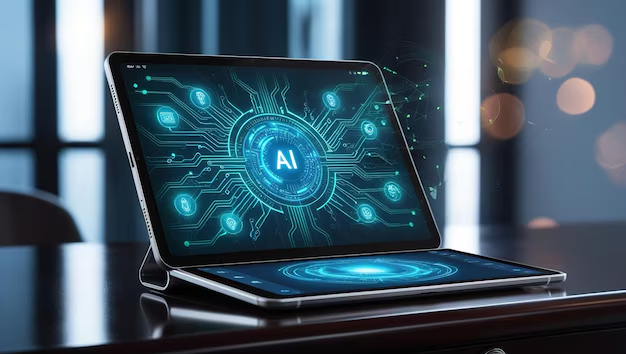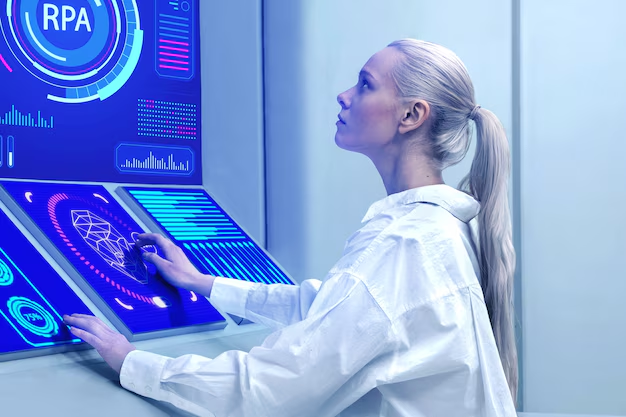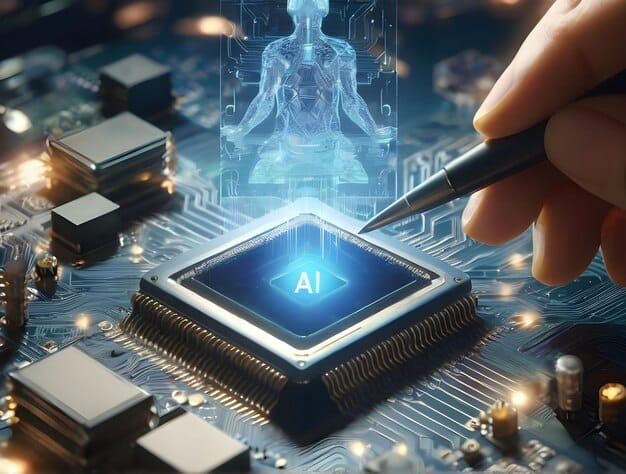In the ever-evolving landscape of technology, the demand for faster, smarter, and more efficient computing solutions continues to grow. As more devices become interconnected and the volume of data generated by these devices surges, traditional cloud computing models struggle to keep up with the need for real-time data processing. This is where edge computing comes into play—bringing computation closer to the data source, thus reducing latency and enhancing the speed of decision-making.
But what if we could make these edge devices faster and smarter? This is the promise of AI-powered edge computing, where artificial intelligence algorithms are deployed directly on edge devices, enabling them to analyze data, make decisions, and act autonomously. Instead of merely being a conduit for data to the cloud, edge devices can now perform sophisticated AI tasks like image recognition, anomaly detection, and predictive analytics right at the source. This shift accelerates response times and allows for enhanced data privacy and security, as sensitive data can be processed locally without needing to be sent to centralized servers.
As businesses across sectors like healthcare, manufacturing, and autonomous vehicles explore the potential of AI-powered edge computing, they are discovering its transformative capabilities. This technology offers a unique blend of speed, intelligence, and efficiency, making it a critical component of next-generation computing architectures. In this blog, we will delve into what AI-powered edge computing is, how it differs from traditional cloud models, its benefits, use cases, challenges, and the future trends shaping its evolution.

The Role of AI in Edge Computing
Artificial Intelligence (AI) and edge computing are a powerful combination that is transforming the way data is processed and analyzed across industries. While edge computing aims to bring data processing closer to the source, AI enhances the intelligence of these edge devices, allowing them to analyze and act on data locally. This combination is enabling a new era of real-time decision-making, reducing latency, optimizing resource usage, and delivering more personalized and responsive experiences. Here’s a closer look at the role AI plays in edge computing:
1. Enabling Real-Time Decision-Making
- One of the core strengths of AI at the edge is its ability to perform data analysis and make decisions in real time. Traditionally, data generated by IoT devices would be sent to cloud servers for processing, introducing delays that can be unacceptable in time-sensitive applications like autonomous driving, industrial automation, or healthcare monitoring.
- With AI models running directly on edge devices, decisions can be made in milliseconds. For example, an autonomous vehicle equipped with edge AI can process data from sensors, detect obstacles, and adjust its path instantly—crucial for ensuring passenger safety and smooth navigation.
2. Reducing the Dependence on Cloud Infrastructure
- AI at the edge reduces the reliance on cloud servers for data processing, which can be both costly and bandwidth-intensive. By analyzing data locally, edge AI minimizes the need to transmit large volumes of data over networks, significantly lowering the bandwidth consumption and associated costs.
- This is especially beneficial in environments with limited or unstable connectivity, such as remote industrial sites, rural areas, or even space missions. AI algorithms on edge devices can operate autonomously without constantly needing to connect to centralized cloud servers.
3. Enhancing Data Privacy and Security
- Processing data locally with AI ensures that sensitive information doesn’t need to be transferred over potentially vulnerable networks to reach the cloud. This is a critical advantage in industries like healthcare, where patient data privacy is paramount, or in financial services, where regulations around data sovereignty are strict.
- Edge AI ensures that personal data remains on the device, reducing the risks of breaches or unauthorized access during data transmission. For example, in a smart home system, AI can analyze audio data directly on a local hub to detect commands or emergencies, without sending recordings to external servers.
4. Optimizing Resource Management with AI
- AI algorithms running on edge devices can continuously monitor resource usage and optimize power, computing, and storage capacities based on real-time data. This is particularly important in settings like industrial IoT, where machinery and equipment generate massive amounts of data that need to be managed efficiently.
- AI models can identify patterns, predict equipment failures, and schedule maintenance before issues arise, reducing downtime and improving overall operational efficiency. This predictive maintenance capability, powered by AI, is a game-changer for industries that rely on heavy machinery and continuous production lines.
5. Personalizing User Experiences
- AI at the edge allows for personalized experiences by analyzing user behavior and preferences in real-time. For example, in smart retail, edge devices equipped with AI can monitor customer movements and interactions within a store, adjusting displays or sending targeted promotions based on their preferences.
- Similarly, in smart homes, AI can analyze user habits to adjust lighting, temperature, and entertainment systems, creating a highly personalized environment without needing to communicate with a remote cloud server.
6. Accelerating AI Model Inference at the Edge
- Edge AI excels in model inference, the phase where an AI model processes new data to produce results. By bringing inference closer to the data source, edge devices can rapidly classify images, detect anomalies, recognize speech, or track movements without the delays associated with cloud processing.
- To make this possible, AI models need to be optimized for edge devices, which often have limited computing resources compared to data centers. Techniques like model compression, pruning, and quantization help shrink AI models to fit within the computational constraints of edge devices, enabling powerful AI capabilities on compact hardware like smart cameras, sensors, and mobile devices.
7. Facilitating Local Collaboration Through Edge AI
- In scenarios where multiple edge devices are deployed, AI can enable them to collaborate and share insights locally without relying on a central server. For example, in a factory, several AI-powered cameras can work together to monitor different aspects of production lines and detect anomalies, collectively improving the accuracy and efficiency of quality control processes.
- This distributed intelligence model, where edge devices communicate and process data amongst themselves, not only increases the robustness of the system but also creates a more resilient network that can continue to function even if connectivity to the cloud is lost.

Key Benefits of AI-Powered Edge Computing
AI-powered edge computing is transforming the way data is processed by bringing intelligence directly to the source. This combination of edge computing and artificial intelligence (AI) delivers a range of advantages that can significantly enhance the efficiency, speed, and security of various systems. Below are the key benefits of leveraging AI-powered edge computing:
1. Reduced Latency and Real-Time Processing
- One of the most significant advantages of AI at the edge is its ability to process data and make decisions with minimal latency. Unlike traditional cloud computing, where data needs to be transmitted to remote servers for processing, edge AI allows devices to analyze data directly where it is generated.
- This low-latency processing is critical for applications that require immediate responses, such as autonomous vehicles, industrial automation, and healthcare monitoring. For example, in autonomous driving, edge AI enables real-time recognition of objects, traffic signs, and obstacles, ensuring quick and safe navigation.
2. Enhanced Data Privacy and Security
- Processing data at the edge means that sensitive information can be analyzed locally without needing to be sent to external cloud servers. This greatly reduces the risk of data breaches during transmission and ensures that private data remains within a controlled environment.
- This benefit is particularly valuable in industries like healthcare, where patient data privacy is a priority, and in financial services, where strict regulations govern data handling. Edge AI can ensure that data is kept secure and compliant with privacy laws by performing tasks such as biometric verification and anomaly detection directly on local devices.
3. Lower Bandwidth Consumption and Reduced Costs
- Transmitting large volumes of data to cloud servers can be expensive, especially for applications that involve continuous data streams from sensors, cameras, and IoT devices. AI at the edge reduces the need for constant data uploads by processing the information locally and only sending the most relevant insights to the cloud.
- This not only lowers bandwidth usage but also helps organizations save on cloud storage and processing costs. For example, in a smart factory, edge devices can analyze production data on-site and send only critical alerts or summarized reports to the cloud, significantly reducing network congestion.
4. Improved Reliability and Operational Continuity
- Relying solely on cloud-based processing can create vulnerabilities in the event of network outages or disruptions. Edge computing, however, enables devices to operate independently and continue performing critical functions even when connectivity to the cloud is lost.
- This makes AI-powered edge computing ideal for applications in remote locations, such as offshore oil rigs, rural areas, or space exploration, where constant internet connectivity cannot be guaranteed. Edge AI ensures that these systems can remain functional, making decisions locally until connectivity is restored.
5. Energy Efficiency and Optimized Resource Use
- AI algorithms at the edge can optimize the use of resources such as power, processing, and storage. By running AI models locally, edge devices can dynamically adjust their operations to reduce energy consumption based on real-time data.
- For instance, AI-powered sensors in smart buildings can adjust lighting and HVAC systems based on occupancy patterns, reducing power usage during off-peak hours. This capability not only enhances energy efficiency but also extends the battery life of edge devices in mobile or remote applications, making them more sustainable.
6. Scalability for Large-Scale IoT Deployments
- As the number of IoT devices continues to grow, centralized cloud systems can become overwhelmed with the sheer volume of data they need to process. AI at the edge helps alleviate this problem by distributing the processing load across multiple edge devices.
- This decentralized approach allows for more scalable systems, enabling industries like manufacturing, logistics, and smart cities to handle large-scale deployments without overburdening cloud servers. Edge AI enables thousands of devices to perform tasks locally, communicating with the cloud only when necessary, thus creating a more balanced and scalable data ecosystem.
7. Personalized and Context-Aware User Experiences
- AI at the edge enables devices to understand and adapt to their surroundings in real time, creating highly personalized user experiences. For example, in retail, AI-powered cameras and sensors can analyze customer behavior, preferences, and buying patterns to offer tailored promotions and product recommendations directly in the store.
- In smart homes, edge AI can learn user habits and preferences, automatically adjusting lighting, temperature, and entertainment options to match the user’s routine. This context-aware capability not only enhances user satisfaction but also makes interactions with technology more intuitive and seamless.
8. Empowering AI-Driven Automation
- AI-powered edge computing allows for the automation of complex processes in real time. In industrial settings, AI can monitor machinery, detect anomalies, and trigger maintenance alerts without human intervention, thus improving the efficiency and reliability of production lines.
- Similarly, in logistics and supply chain management, edge AI can track inventory levels, optimize routing for delivery trucks, and ensure quality control during transport. By enabling AI-driven automation at the device level, businesses can streamline operations and achieve greater productivity.
9. Supporting Emerging Technologies
- AI at the edge is playing a crucial role in the advancement of technologies like augmented reality (AR), virtual reality (VR), and the Internet of Things (IoT). For example, AR applications require real-time image processing and recognition, which is best achieved by leveraging AI on edge devices such as smartphones or AR glasses.
- In the case of IoT, edge AI can process sensor data locally, enabling devices to act intelligently and autonomously in environments like smart factories, cities, or healthcare facilities. This synergy between AI and edge computing opens up new possibilities for innovation, driving the development of next-generation applications.

Use Cases of AI-Powered Edge Computing
AI-powered edge computing has emerged as a game-changing technology across various industries, enabling real-time data processing and intelligent decision-making closer to the source of data generation. By integrating AI capabilities directly into edge devices, organizations can overcome latency challenges, enhance data security, and create highly responsive applications. Here are some of the most prominent use cases where AI-powered edge computing is making a significant impact:
1. Autonomous Vehicles and Advanced Driver Assistance Systems (ADAS)
- Autonomous vehicles rely heavily on real-time data analysis to navigate safely. AI at the edge processes data from cameras, LiDAR, radar, and other sensors directly on the vehicle, making split-second decisions to identify obstacles, pedestrians, and other vehicles.
- This real-time processing is crucial for tasks such as lane detection, traffic sign recognition, and collision avoidance, allowing vehicles to react instantly to changing road conditions without needing to communicate with cloud servers.
- ADAS systems also benefit from edge AI by providing driver alerts and assistance based on real-time analysis, enhancing safety even in non-autonomous vehicles.
2. Industrial Automation and Predictive Maintenance
- AI-powered edge computing is transforming manufacturing by enabling smarter, more efficient operations on the factory floor. Edge devices equipped with AI can monitor machinery, detect anomalies, and predict maintenance needs before failures occur, minimizing downtime and repair costs.
- By processing data directly from sensors on-site, edge AI can provide real-time insights into machine health, operational efficiency, and quality control. This allows manufacturers to optimize production processes and ensure consistent product quality without relying on external cloud servers.
- Additionally, in environments like oil and gas refineries or power plants, edge AI ensures that critical systems continue to function even in remote or hazardous locations where cloud connectivity is limited.
3. Healthcare and Remote Patient Monitoring
- AI at the edge is playing a critical role in improving patient care through real-time health monitoring and diagnostics. Wearable devices and IoT-enabled medical equipment can analyze patient data locally, detecting abnormalities in heart rate, blood pressure, or glucose levels and alerting healthcare providers immediately.
- This is particularly valuable in remote or rural areas where constant cloud connectivity may not be available. AI-powered edge devices can monitor patients with chronic conditions, analyze vital signs, and provide insights directly to doctors, allowing for timely interventions.
- In hospital settings, edge AI can support medical imaging analysis, enabling faster diagnostics through localized image recognition for X-rays, MRIs, and CT scans, reducing the time it takes to identify critical conditions.
4. Smart Cities and Public Safety
- Edge AI is a key enabler of smart city initiatives, helping cities become more efficient, safe, and responsive. For example, AI-powered surveillance cameras can analyze video feeds locally to detect suspicious activities, identify traffic violations, and monitor crowd movements in real-time.
- Traffic management systems use AI at the edge to analyze data from sensors and cameras, optimizing traffic light timings, reducing congestion, and improving overall flow. This localized processing ensures that decisions are made instantly without needing to send data to a centralized server.
- Additionally, edge AI can be used for environmental monitoring in urban areas, analyzing air quality, noise levels, and waste management in real-time, enabling city planners to address issues more quickly.
5. Retail and Customer Experience Optimization
- In the retail sector, AI-powered edge devices can enhance the customer shopping experience through real-time insights and automation. For example, smart shelves and cameras equipped with AI can monitor stock levels, track customer movements, and analyze shopper behavior to optimize store layouts and displays.
- Edge AI enables cashless checkout systems by using computer vision to automatically identify items and process payments, reducing wait times and improving customer satisfaction. These systems can operate even if internet connectivity is temporarily lost, ensuring a seamless shopping experience.
- Retailers can also use edge AI to deliver personalized promotions and recommendations based on a shopper’s in-store behavior, providing a tailored experience without relying on cloud-based analytics.
6. Agriculture and Precision Farming
- AI-powered edge computing is revolutionizing agriculture by enabling precision farming techniques that optimize crop yield, water usage, and resource management. Drones and edge-enabled sensors can analyze soil conditions, crop health, and moisture levels, providing real-time data to farmers for better decision-making.
- Edge AI allows these devices to make localized adjustments, such as adjusting irrigation levels or identifying areas that require fertilization, without needing to send data back to a remote cloud. This reduces latency and helps farmers respond quickly to changes in environmental conditions.
- In livestock management, edge AI can monitor the health and behavior of animals through wearables, helping farmers detect early signs of illness or stress and take timely action.
7. Augmented Reality (AR) and Virtual Reality (VR)
- AR and VR applications require real-time processing to create immersive and interactive experiences, making them ideal candidates for AI-powered edge computing. By processing data directly on AR/VR devices like smart glasses or headsets, edge AI can deliver seamless visuals and interactions without the delay associated with cloud-based processing.
- For example, in industrial training or remote assistance, AR headsets with edge AI can overlay instructions or diagrams onto real-world objects, helping technicians or trainees perform complex tasks with real-time guidance.
- In gaming, edge AI can enhance user experiences by providing adaptive gameplay, real-time character interactions, and localized game environment adjustments, all while minimizing latency and improving responsiveness.
8. Logistics and Supply Chain Optimization
- AI-powered edge devices are streamlining logistics operations by providing real-time insights into inventory levels, tracking shipments, and monitoring conditions during transport. Smart sensors can analyze temperature, humidity, and vibrations inside containers, ensuring that perishable goods are kept within optimal conditions.
- By processing this data locally, edge AI can trigger alerts if conditions deviate from set parameters, allowing for quick interventions without needing constant cloud connectivity. This ensures that sensitive shipments, such as pharmaceuticals or fresh produce, are delivered in optimal condition.
- Additionally, edge AI enables autonomous drones and robots to navigate warehouses, restock shelves, and transport goods efficiently, reducing manual labor and improving operational speed.
9. Energy Management and Smart Grids
- In the energy sector, AI-powered edge computing enables the creation of smart grids that can monitor and manage electricity distribution in real time. Edge devices can analyze data from sensors and meters, balancing supply and demand and optimizing energy consumption across a network.
- AI at the edge helps detect power outages, predict equipment failures, and manage renewable energy sources like solar and wind power by analyzing weather patterns and adjusting generation levels accordingly.
- This local intelligence is particularly useful in remote areas or regions with unstable connectivity, where the grid can operate autonomously to ensure a consistent and efficient energy supply.
10. Financial Services and Fraud Detection
- In the financial sector, edge AI is being used to enhance security and improve customer experiences. For example, ATMs and point-of-sale (POS) terminals equipped with edge AI can detect fraudulent transactions or abnormal activity patterns without sending data to the cloud, allowing banks to take immediate action.
- Edge AI can also power facial recognition systems for secure authentication, enabling contactless transactions and enhancing user security at ATMs or mobile banking apps.
- Additionally, edge devices in retail banking branches can analyze foot traffic and customer behavior to optimize staffing levels, improve service quality, and deliver personalized product recommendations.
Challenges in Implementing AI at the Edge
While AI-powered edge computing offers numerous benefits, such as reduced latency, improved data security, and real-time decision-making, implementing AI at the edge comes with its own set of challenges. These hurdles can impact the effectiveness and scalability of edge AI solutions, especially when dealing with diverse industries and applications. Here are some of the key challenges that organizations face when deploying AI at the edge:

1. Limited Computational Resources
- Edge devices often have constrained computational power compared to traditional cloud servers. Implementing AI algorithms, especially deep learning models, requires significant processing power, which can be a challenge for smaller, less capable edge devices like sensors, IoT devices, and microcontrollers.
- Unlike cloud environments, which can leverage vast computing resources for training and inference, edge devices need to run AI models efficiently within the limited CPU, GPU, and memory available locally.
- To address this, models must be optimized for edge deployment using techniques like model compression, pruning, or quantization, but these processes can be complex and require expertise.
2. Energy Consumption and Power Constraints
- Edge devices are often deployed in environments where power availability is limited, such as remote locations, industrial sites, or battery-operated devices like drones or wearables. Running AI models locally can consume significant energy, which may deplete power sources quickly.
- The challenge is to balance the need for real-time AI inference with the power constraints of edge devices. More efficient models and hardware, such as AI-specific accelerators and low-power processors, are needed to optimize energy consumption.
- This limitation can restrict the complexity of AI models that can be run on the edge, potentially requiring a trade-off between accuracy and power consumption.
3. Data Privacy and Security Concerns
- One of the main advantages of edge computing is improved data privacy, as data is processed locally without being sent to the cloud. However, this also means that the responsibility for securing sensitive data shifts to the edge device itself.
- Edge devices can become targets for cyberattacks, especially if they are deployed in remote or less secure environments. Ensuring that AI models and data remain secure throughout the lifecycle of the device—from training to deployment and ongoing operation—can be challenging.
- Implementing encryption, secure boot mechanisms, and regular firmware updates can help, but these measures can also increase complexity and costs for edge deployments.
4. Model Deployment and Management
- Deploying AI models at the edge is not as straightforward as in cloud environments. Edge devices can be geographically dispersed, making it difficult to update models, monitor their performance, or troubleshoot issues in real time.
- Managing and maintaining AI models across a large number of edge devices requires robust model deployment strategies, including mechanisms for over-the-air (OTA) updates and remote monitoring.
- Additionally, models may need to be retrained or fine-tuned periodically based on new data, which is more complex to manage when edge devices are located far from centralized training infrastructure.
5. Data Quality and Availability
- For AI models to make accurate decisions at the edge, they require high-quality data. However, data generated by edge devices can vary significantly in terms of quality and format, especially in environments like industrial automation or remote monitoring.
- Noise, environmental conditions, or faulty sensors can affect the quality of data gathered at the edge, leading to incorrect predictions or decisions by AI models. Preprocessing data at the edge to filter out noise can be resource-intensive, adding to the challenge.
- Additionally, while edge devices may generate large volumes of data, they often lack the storage capacity to retain historical data, which can limit the ability to perform deeper analysis or improve models over time.
6. Integration with Existing Infrastructure
- Integrating AI-powered edge solutions into existing systems and infrastructure can be complex, especially in industries like manufacturing, healthcare, or agriculture, where legacy systems may still be in use.
- Ensuring that edge AI solutions can communicate seamlessly with older systems, databases, and protocols often requires significant customization and development work.
- The lack of standardization in edge computing platforms and communication protocols can further complicate integration, requiring organizations to invest in custom middleware or edge orchestration solutions to ensure smooth data flow between devices.
7. Latency and Real-Time Processing Requirements
- While edge computing is designed to reduce latency by processing data closer to its source, achieving real-time processing still depends on the capabilities of the edge hardware and the complexity of the AI model.
- For applications such as autonomous vehicles, industrial automation, or healthcare monitoring, even a small delay can have significant consequences. Therefore, edge AI solutions need to be carefully designed to meet stringent latency requirements.
- Optimizing AI models to run faster on edge devices while maintaining accuracy requires expertise in AI model architecture, which can add complexity to the deployment process.
8. Scalability Challenges
- Scaling AI-powered edge solutions across a large number of devices or geographic locations presents unique challenges. Managing a few edge devices is relatively simple, but as deployments grow, the complexity of managing hardware, software, and connectivity increases significantly.
- Organizations need to implement robust edge orchestration and management platforms that can handle the deployment, monitoring, and updates of AI models across hundreds or thousands of devices.
- This scalability challenge is particularly evident in applications like smart cities, where numerous edge devices, such as cameras, sensors, and IoT devices, need to work together seamlessly to deliver real-time insights.
9. Cost of Edge Hardware and AI Accelerators
- While edge computing can reduce costs related to data transmission and cloud storage, the initial investment in edge devices, AI accelerators, and specialized hardware can be significant.
- Deploying edge AI solutions often requires investing in hardware like GPUs, TPUs, or other AI-specific processors that are designed to handle intensive AI workloads locally.
- These costs can be prohibitive, especially for small businesses or startups, making it essential to carefully evaluate the return on investment (ROI) for deploying AI at the edge.
10. Regulatory and Compliance Challenges
- In industries such as healthcare, finance, and autonomous driving, strict regulatory requirements govern data processing, storage, and AI model performance. Deploying AI models on edge devices needs to comply with these regulations, which can vary by region or industry.
- Ensuring that edge AI solutions meet compliance requirements can add an additional layer of complexity to the deployment process, requiring organizations to maintain detailed records, implement auditing capabilities, and ensure data protection measures.
- Failure to meet regulatory standards can result in legal challenges or fines, making compliance a critical consideration in edge AI deployments.
Conclusion
AI-powered edge computing represents a transformative shift in how data is processed, analyzed, and acted upon. By bringing intelligence directly to the device level, it enables faster decision-making, improved data security, and greater efficiency across various industries.
From enhancing real-time applications like autonomous vehicles and smart cities to supporting critical functions in healthcare and industrial automation, the potential of AI at the edge is vast.
However, realizing this potential comes with its challenges. Limited computational resources, energy constraints, and data privacy concerns are just a few of the hurdles organizations must navigate.
Overcoming these obstacles requires thoughtful planning, investment in optimized AI models, and robust deployment strategies. It also necessitates collaboration between hardware developers, AI experts, and industry stakeholders to create solutions that can operate efficiently within the constraints of edge environments.
As advancements in hardware, software, and AI algorithms continue, the future of AI-powered edge computing looks promising. Organizations that embrace this technology today can gain a competitive edge, driving innovation and delivering new capabilities that enhance user experiences and improve operational outcomes.
By addressing the challenges and capitalizing on the opportunities, AI at the edge can truly become a game-changer in the digital era.












